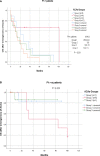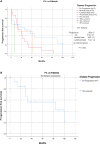Differential prognostic impact of stratified additional chromosome abnormalities on disease progression among Malaysian chronic myeloid leukemia patients undergoing treatment with imatinib mesylate
- PMID: 36003793
- PMCID: PMC9393706
- DOI: 10.3389/fonc.2022.720845
Differential prognostic impact of stratified additional chromosome abnormalities on disease progression among Malaysian chronic myeloid leukemia patients undergoing treatment with imatinib mesylate
Abstract
The emergence of additional chromosome abnormalities (ACAs) in chronic myeloid leukemia (CML) patients during treatment with a tyrosine kinase inhibitor (TKI) regime is generally associated with resistance to treatment and a sign of disease progression to accelerated phase or blast phase. We report the type, frequency, and differential prognostic impact of stratified ACAs with treatment response in 251 Malaysian CML patients undergoing TKI therapy. ACAs were observed in 40 patients (15.9%) of which 7 patients (17.5%) showed ACAs at time of initial diagnosis whereas 33 patients (82.5%) showed ACAs during the course of IM treatment. In order to assess the prognostic significance, we stratified the CML patients with ACAs into four groups, group 1 (+8/+Ph), group 2 (hypodiploidy), group 3 (structural/complex abnormalities); group 4 (high-risk complex abnormalities), and followed up the disease outcome of patients. Group 1 and group 2 relatively showed good prognosis while patients in group 3 and group 4 had progressed or transformed to AP or blast phase with a median survival rate of 12 months after progression. Novel ACAs consisting of rearrangements involving chromosome 11 and chromosome 12 were found to lead to myeloid BP while ACAs involving the deletion of 7q or monosomy 7 led toward a lymphoid blast phase. There was no evidence of group 2 abnormalities (hypodiploidy) contributing to disease progression. Compared to group 1 abnormalities, CML patients with group 3 and group 4 abnormalities showed a higher risk for disease progression. We conclude that the stratification based on individual ACAs has a differential prognostic impact and might be a potential novel risk predictive system to prognosticate and guide the treatment of CML patients at diagnosis and during treatment.
Keywords: additional chromosome abnormalities (ACAs); chronic myeloid leukemia; disease progression; imatinib mesylate; resistance; stratification.
Copyright © 2022 Siti Mariam, Norhidayah, Zulaikha, Nazihah, Rosline, Kausar, Sarina, Azlan and Ankathil.
Conflict of interest statement
The authors declare that the research was conducted in the absence of any commercial or financial relationships that could be construed as a potential conflict of interest.
Figures



Similar articles
-
Prognostic importance of additional cytogenetic anomalies in chronic myeloid leukemia.Med Oncol. 2013 Mar;30(1):443. doi: 10.1007/s12032-012-0443-1. Epub 2013 Jan 5. Med Oncol. 2013. PMID: 23292838
-
Risk stratification of chromosomal abnormalities in chronic myelogenous leukemia in the era of tyrosine kinase inhibitor therapy.Blood. 2016 Jun 2;127(22):2742-50. doi: 10.1182/blood-2016-01-690230. Epub 2016 Mar 22. Blood. 2016. PMID: 27006386 Free PMC article. Clinical Trial.
-
Chronic myeloid leukemia with complex karyotypes: Prognosis and therapeutic approaches.J Cell Physiol. 2019 May;234(5):5798-5806. doi: 10.1002/jcp.27505. Epub 2018 Nov 14. J Cell Physiol. 2019. PMID: 30430567 Review.
-
Cytogenetic landscape and impact in blast phase of chronic myeloid leukemia in the era of tyrosine kinase inhibitor therapy.Leukemia. 2017 Mar;31(3):585-592. doi: 10.1038/leu.2016.231. Epub 2016 Aug 18. Leukemia. 2017. PMID: 27560111
-
Cytogenetic and molecular genetic evolution of chronic myeloid leukemia.Acta Haematol. 2002;107(2):76-94. doi: 10.1159/000046636. Acta Haematol. 2002. PMID: 11919388 Review.
Cited by
-
Signaling pathways governing the behaviors of leukemia stem cells.Genes Dis. 2023 Mar 23;11(2):830-846. doi: 10.1016/j.gendis.2023.01.008. eCollection 2024 Mar. Genes Dis. 2023. PMID: 37692500 Free PMC article. Review.
-
Chronic Myeloid Leukemia, from Pathophysiology to Treatment-Free Remission: A Narrative Literature Review.J Blood Med. 2023 Apr 6;14:261-277. doi: 10.2147/JBM.S382090. eCollection 2023. J Blood Med. 2023. PMID: 37051025 Free PMC article. Review.
References
-
- Sawyers CL, Hochhaus A, Feldman E, Goldman JM, Miller CB, Ottmann OG, et al. . Imatinib induces hematologic and cytogenetic responses in patients with chronic myelogenous leukemia in myeloid blast crisis: results of a phase II study: Presented in part at the 43rd annual meeting of the American society of hematology, Orlando, FL, December 11, 2001. Blood (2002) 99(10):3530–9. doi: 10.1182/blood.V99.10.3530 - DOI - PubMed
LinkOut - more resources
Full Text Sources
Research Materials

